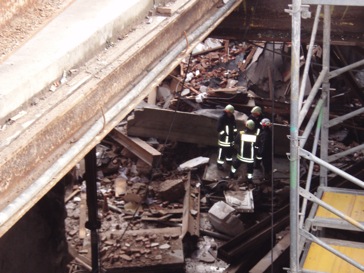Rescue Robots at the Cologne Germany Building Collapse
I finished The Mystic Arts of Erasing All Signs of Death by Charlie Huston just before the City Archives collapsed in Cologne, Germany, on March 3. I soon found myself at my 11th disaster, but unlike Webb, the protagonist who must come to grips with the events that led him to a janitorial job cleaning up trauma sites, I was clear on why I was there standing in the rain. I was there in the hope that we could make a difference with technology — that we could enable the fire rescue teams to save a life, prevent a responder’s death, or even bring a family’s agonizing wait to closure. Or to help the structural engineers discover and document What Went Wrong. And, if not that, learn something for the next time.
We accomplished option C at least.
Let me offer this photograph as the spoiler alert for my personal blog (rescuerobotics.blogspot.com) which has details, history of robots for building collapses, and some pictures and video. In the picture, I’m on the right, down at the mid-level of the collapse (there were two more stories of flooded or damaged subway structure below us) with the Cologne Chief of the Fire Department, the head of special operations, and the safety officer (all wearing reflective bunker gear). The photo was snapped a few minutes after we had reached the conclusion that robots could not be used. In the photo we are chatting about the collapse, the dangers, the sequence of events that had led to the catastrophe and resulting challenges before clambering up the scaffolding to the safer street level.

Standing there in Germany, I couldn’t help but be reminded of all the ways computing could be applied. Robots. Cyber-physical systems. Sensors to penetrate the rubble and algorithms to process and mine the data. Reliable and secure high bandwidth wireless networks. Optimal resource allocations and scheduling. Mapping and 3D surface reconstruction. Sketch-based and multi-modal interfaces to tablet PCs to make it easier for the experts to express their knowledge. Social networking to help the displaced residents figure out how to adapt, where their friends had been relocated to, what was really going on.
Looking again at the photograph brings me back to the The Mystic Arts. I was particularly touched as to how at the end of the novel Webb comes to view his work as a sacred duty. The disaster “lifecycle” of prevention, preparedness, response, and recovery is a lot like trauma work — it is infrequent, not well-funded or understood, very challenging, and ultimately inevitable. Standing there in Germany, I glimpsed the journey ahead for the computing community as we, too, embrace the difficult and necessary, and make the field of emergency informatics our sacred duty as computing, well applied, can help erase all signs (and maybe the causes) of death.
— Robin Murphy is a Professor at Texas A&M University, and one of the newest members of the CCC Council. Previously, Robin’s robots also conducted search-and-rescue operations at the World Trade Center shortly after 9/11.










Trackbacks /
Pingbacks